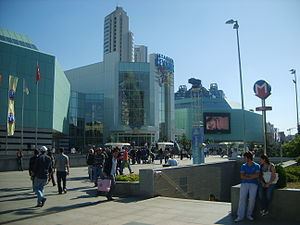Lowest elevation 70 m (230 ft) Area code(s) 0-212 | Highest elevation 140 m (460 ft) Time zone EET (UTC+2) | |
 | ||
Postal code 34360, 34371, 34373, 34375, 34377, 34379, 34380, 34382, 34394, 34396 | ||
Şişli ([ˈʃiʃli]) is one of 39 districts of Istanbul, Turkey. Located on the European side of the city, it is bordered by Beşiktaş to the east, Sarıyer to the north, Eyüp and Kağıthane to the west, and Beyoğlu to the south. In 2009, Şişli had a population of 316,058.
Contents
- Map of C59EiC59Fli 19 MayC4B1s Mahallesi 34360 C59EiC59Fli2FC4B0stanbul Turkey
- History
- The centre of ili today
- Business and shopping
- Neighbourhoods
- Politics
- Places of interest
- References
Map of %C5%9Ei%C5%9Fli, 19 May%C4%B1s Mahallesi, 34360 %C5%9Ei%C5%9Fli%2F%C4%B0stanbul, Turkey
History
Until the 1800s, Şişli was open countryside, used for hunting and agriculture and leisure. It was developed as a middle class residential district during the last years of the Ottoman Empire and the early years of the Turkish Republic (the late 19th-early 20th centuries). French culture had a great influence in this period and the big avenues of Şişli had a European look; big stone buildings with high ceilings and art nouveau wrought-iron balconies, little elevators on wires in the middle of the stairway and so on. This trading middle-class was composed of Jews, Greeks and Armenians as well as Turks, many built homes in Şişli after a large fire in the district of Beyoğlu in 1870. Still today many families of Istanbul's local Armenian community live in the Kurtuluş neighbourhood of Şişli. The area was also popular with the Levantine trading families of this period who settled for trade or were contracted by the Ottoman Empire. Şişli attracted migrants from the former lands in Greece and the Balkans. In the late 19th century Şişli was one of the first areas supplied with tramlines, electricity and a gas supply. The orphanage of Darülaceze and the large Şişli Etfal Hospital were built here in this period, as well as the French schools of St. Michel and Notre Dame de Sion.
Following the founding of the Turkish Republic in the 1920s, larger and larger buildings were put up along wide avenues such as Halaskargazi Caddesi, the main road that runs through the middle of Şişli, with its little arcades of shops below tall buildings of apartments and offices. In the republic the area was still the residence of the middle-class, as well as traders there were now writers and poets and Şişli acquired theatres, cafes and other cultural amenities. The Hilton Istanbul Bosphorus was built here in the 1950s and many others followed.
From the 1950s onwards people from Anatolia began to migrate to Istanbul in search of work. In most cases they illegally built themselves squatters on unclaimed or government-owned land (see gecekondu). Some of these people settled in parts of Şişli in the 1950s and 1960s, especially at the northern sections of the district, around Mecidiyeköy.
The centre of Şişli today
Now that the wealthy elite of central Şişli have moved further out of the city, the large buildings on the grand avenues are occupied by offices, banks, and big shops. Since the 1970s most older buildings have been pulled down and replaced with newer, and perhaps less remarkable, multistory structures. The back streets are still residential, and many working-class families and students have settled here. As in most parts of Istanbul, the number of people living and working in these blocks challenges the existing infrastructure; for example, competition for parking spaces is intense, and traffic during peak hours can come to a standstill. But for the residents of Şişli, there are plenty of shops, cafés, pubs, and other amenities and these make life in Şişli pleasant. Additionally, Şişli's central location to other important areas of Istanbul adds to its desirability.
Business and shopping
Being a central area well-served with public-transport and other infrastructure, Şişli is a center of trade and shopping. The main road through Şişli up to the skyscrapers of Mecidiyeköy, Gayrettepe, Levent and beyond is now lined with office blocks. Europe's largest and the world's second largest (urban-area) shopping mall, Cevahir İstanbul, is situated here. Due to Şişli's middle-class past and the enduring quality of some neighbourhoods the area is home to many upmarket shops mainly in the stylish and charming Nişantaşı area. Parking is an enduring problem, especially in the narrow side-streets.
People also come to Şişli for schooling; this city-centre area has some well-known high schools and a great number of dersane (preparatory courses for the annual university entrance exams), evening and weekend schools where people come to cram for university or high school entrance examinations, or to learn English.
There are many well-established cafes and restaurants, including fast-food for the students and shoppers.
Neighbourhoods
Politics
The mayor of Şişli is Hayri İnönü.
